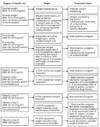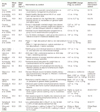Abstract
Figures and Tables
 | Figure 2Relationship of body mass index (BMI) to risk (mortality). The curvilinear plot is based on data adapted from the American Cancer Society study. As BMI increases the excess risk rises. A healthy or good body weight range is between 19 and 27 kg/m2 (From Bray GA. Am J Clin Nutr 1992;55:488S-494S, with permission from American Society for Nutrition) [14]. |
 | Figure 3Burden of disease, preventability, and research and translation gaps (From Ockene JK, et al. Am J Prev Med 2007;32:244-252, with permission from Elsevier) [15]. |
 | Figure 4Treatment algorithm for the assessment of patients with overweight and obesity. BMI, body mass index; F, females; Hx, history; M, males (From NHLBI Obesity Education Initiative. Practical guide to the identification, evaluation, and treatment of overweight and obesity in adults. Bethesda [MD]: National Institute of Health; 2000) [13]. |
 | Figure 5The triple-tier pathway for weight management (From Maryon-Davis A. Proc Nutr Soc 2005;64:97-103, with permission from Cambridge University Press) [16]. |
 | Figure 6Summary flow chart on the prevention and therapy of obesity in Germany. BMI, body mass index. a)Healthy lifestyle means living according to the recommendations of the best practice program. b)Referral to specialist (diabetologist with focus on obesity, surgeon), if necessary (From Gandjour A, et al. Int J Qual Health Care 2001;13:325-332, with permission from Afschin Grandjour) [12]. |
 | Figure 7Mean weight loss in 4 treatment groups of Wadden trial (From Wadden TA, et al. N Engl J Med 2005;353:2111-2120, with permission from Massachusetts Medical Society) [25]. |
Table 1

From NHLBI Obesity Education Initiative. Practical guide to the identification, evaluation, and treatment of overweight and obesity in adults. Bethesda (MD): National Institute of Health; 2000 [13].
Table 2

a)Disease risk for type 2 diabetes mellitus, hypertension, and cardiovascular disease.
b)Increased waist circumference can also be a marker for increased risk even in persons of normal weight.
From World Health Organ Tech Rep Ser 2000;894:i-xii, 1-253 [7].
Table 3

NIDDM, non-insulin-dependent diabetes mellitus; CHD, coronary heart disease.
From World Health Organ Tech Rep Ser 2000;894:i-xii, 1-253 [7].
Table 4

From Centers for Disease Control and Prevention. Guide to community preventive services. Atlanta (GA): Centers for Disease Control and Prevention (US); 2005 [10].
Table 5

From Dickerson VM. Obstet Gynecol Surv 2001;56:650-663, with permission from Wolters Kluwer Health [23]
Table 6

Bw, biweekly; D, diet; E, exercise; WF, weight-focused; EF, exercise-focused; H, home-based exercise; G, group-based exercise; Lb, long-bout exercise; Sb, short-bout exercise; SbE, short-bout exercise with home equipment. a)Included short-term use of a low-calorie liquid diet. b)Included use of low-calorie or balanced-deficit diet. IOMC, Institute of Medicine Criterion for successful long-term loss (≥5% body weight lost and maintained for>1 year). *,c)Means with differing superscripts indicate significant between-group differences (p<0.05) (From Lang A, et al. Eur J Cardiovasc Nurs 2006;5:102-114, with permission from Elsevier) [24].
Table 7

a)Data obtained from only one trial.
b)Data obtained from the Diabetes Prevention Program Trial; individuals with impaired fasting glucose were treated with drug.
From Aronne LJ, et al. Am J Med 2009;122(4 Suppl 1):S24-S32, with permission from Elsevier [26]
Table 8

From Wolf AM, et al. Am J Med 2009;122(4 Suppl 1):S19-S23, with permission from Elsevier [11]
Table 9

NCEP, National Cholesterol Education Program; CV, cardiovascular; LCD, low-calorie diet; VLCD, very-low-calorie diet.
From Strychar I. CMAJ 2006;174:56-63, with permission from Canadian Medical Association [28].
Table 10

*denotes significant vs. control
AHA, American Heart Association; BMI, body mass index; HELP, Healthy Eating and Lifestyle Program; LCD, low-calorie diet: VLCD, very low-calorie diet.
From Osei-Assibey G, et al. Obes Rev 2010;11:769-776, with permission from John Wiley and Sons [34]




 PDF
PDF ePub
ePub Citation
Citation Print
Print



 XML Download
XML Download